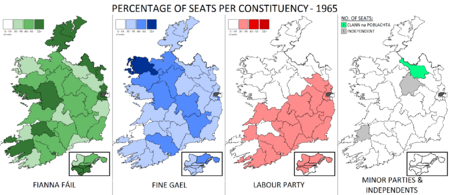Irish general election, 1965
|
|
|||||||||||||||||||||||||||||||||||||||||||||||||||||||||||||||||||||||||||||
|---|---|---|---|---|---|---|---|---|---|---|---|---|---|---|---|---|---|---|---|---|---|---|---|---|---|---|---|---|---|---|---|---|---|---|---|---|---|---|---|---|---|---|---|---|---|---|---|---|---|---|---|---|---|---|---|---|---|---|---|---|---|---|---|---|---|---|---|---|---|---|---|---|---|---|---|---|---|
|
|||||||||||||||||||||||||||||||||||||||||||||||||||||||||||||||||||||||||||||
|
|
|||||||||||||||||||||||||||||||||||||||||||||||||||||||||||||||||||||||||||||
|
143 of 144 seats in Dáil Éireann 72 seats were needed for a majority |
|||||||||||||||||||||||||||||||||||||||||||||||||||||||||||||||||||||||||||||
| Turnout | 75.1% | ||||||||||||||||||||||||||||||||||||||||||||||||||||||||||||||||||||||||||||
|
|||||||||||||||||||||||||||||||||||||||||||||||||||||||||||||||||||||||||||||

Percentage of seats gained by each of the three major parties, and number of seats gained by smaller parties and independents.
|
|||||||||||||||||||||||||||||||||||||||||||||||||||||||||||||||||||||||||||||
|
|||||||||||||||||||||||||||||||||||||||||||||||||||||||||||||||||||||||||||||
The Irish general election of 1965 was held on 7 April 1965. The newly elected members of the 18th Dáil assembled at Leinster House on 21 April when the new Taoiseach and government were appointed.
The general election took place in 42 parliamentary constituencies throughout Ireland for 144 seats in the lower house of parliament, Dáil Éireann.
The general election of 1965 was caused by the ruling Fianna Fáil party's failure to gain a seat in a by-election. The success of Eileen Desmond of the Labour Party in Cork Mid in holding a seat previously held by her husband Dan Desmond, led to an unacceptable mathematical situation with regard to the government's majority. The Taoiseach, Seán Lemass immediately dissolved the Dáil and the campaign began in earnest.
Fianna Fáil ran its campaign on its record in government. Over the last number of years the economy had seen a huge improvement and the party played up on its record in government. The party also played up heavily on the personality of the party leader with the slogan "Let Lemass Lead On". Fine Gael put forward a comprehensive manifesto, which included the establishment of a government department concerned with economic planning. However, the older, conservative members of the party did not warm to the new turn the party was taking.
This was the first Irish General Election to be covered on television by state broadcaster RTÉ, which had formed on 31 December 1961. Election Newsroom was broadcast live on Telefís Éireann from their Donnybrook studios in Dublin, presented by John O'Donoghue with analysis provided by John Healy (Irish Times), John O'Sullivan (The Cork Examiner), Garret FitzGerald and Professor Basil Chubb. Cameras were present in four count centres: Bolton Street (Dublin), Wexford, Cork and Monaghan. The GPO provided direct links as results were announced. Raidió Éireann provided special coverage from 3 pm on the day of the count due to the coverage on Telefís Éireann. It was a new approach to election coverage on the state's radio service, which began broadcasting in 1926.
...
Wikipedia


